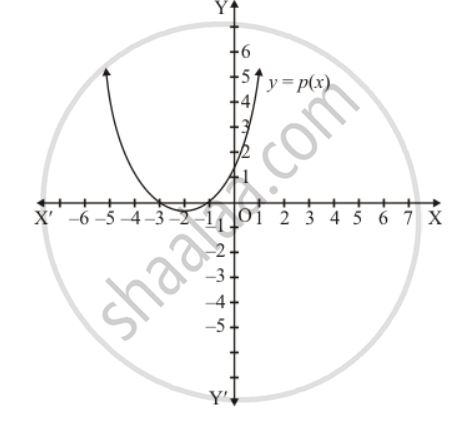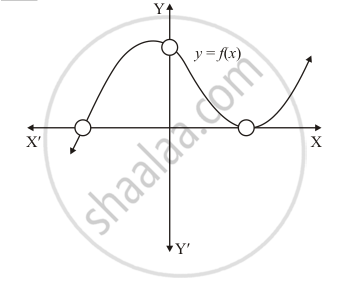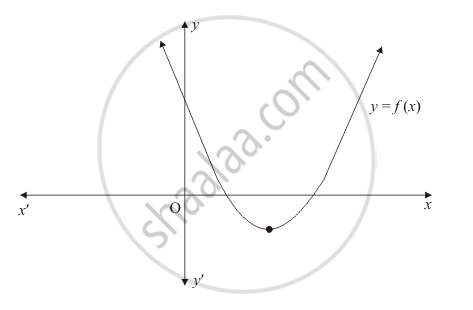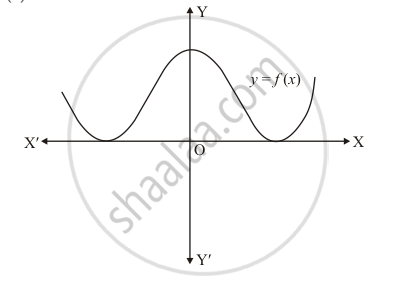Advertisements
Online Mock Tests
Chapters
▶ 2: Polynomials
3: Pair of Linear Equations in Two Variables
4: Quadratic Equations
5: Arithmetic Progression
6: Co-Ordinate Geometry
7: Triangles
8: Circles
9: Constructions
10: Trigonometric Ratios
11: Trigonometric Identities
12: Trigonometry
13: Areas Related to Circles
14: Surface Areas and Volumes
15: Statistics
16: Probability
![RD Sharma solutions for Mathematics [English] Class 10 chapter 2 - Polynomials RD Sharma solutions for Mathematics [English] Class 10 chapter 2 - Polynomials - Shaalaa.com](/images/8193647920-mathematics-english-class-10_6:5809898a5fef45e9a2f7e6b414d392fa.jpg)
Advertisements
Solutions for Chapter 2: Polynomials
Below listed, you can find solutions for Chapter 2 of CBSE RD Sharma for Mathematics [English] Class 10.
RD Sharma solutions for Mathematics [English] Class 10 2 Polynomials Exercise 2.1 [Pages 33 - 35]
Find the zeroes of the following quadratic polynomial and verify the relationship between the zeroes and the coefficients:
x2 – 2x – 8
Find the zeroes of the following quadratic polynomial and verify the relationship between the zeroes and the coefficients:
4s2 – 4s + 1
Find the zeroes of the following quadratic polynomial and verify the relationship between the zeroes and the coefficients:
t2 – 15
Find the zeroes of the following quadratic polynomials and verify the relationship between the zeroes and the coefficients
`p(x) = x^2 + 2sqrt2x + 6`
Find the zeroes of the following quadratic polynomials and verify the relationship between the zeroes and the coefficients
`q(x)=sqrt3x^2+10x+7sqrt3`
Find the zeroes of the following quadratic polynomials and verify the relationship between the zeroes and the coefficients
`f(x)=x^2-(sqrt3+1)x+sqrt3`
Find the zeroes of the following quadratic polynomials and verify the relationship between the zeroes and the coefficients
`g(x)=a(x^2+1)-x(a^2+1)`
Find the zeroes of the following quadratic polynomial and verify the relationship between the zeroes and the coefficients.
6x2 – 3 – 7x
If α and β are the zeros of the quadratic polynomial f(x) = ax2 + bx + c, then evaluate α - β
If α and β are the zeros of the quadratic polynomial f(x) = ax2 + bx + c, then evaluate `1/alpha-1/beta`
If α and β are the zeros of the quadratic polynomial f(x) = ax2 + bx + c, then evaluate `1/alpha+1/beta-2alphabeta`
If α and β are the zeros of the quadratic polynomial f(x) = ax2 + bx + c, then evaluate α2β + αβ2
If α and β are the zeros of the quadratic polynomial f(x) = ax2 + bx + c, then evaluate α4 + β4
If α and β are the zeroes of the quadratic polynomial f(x) = ax2 + bx + c, then evaluate `1/(aalpha+b)+1/(abeta+b)`.
If α and β are the zeros of the quadratic polynomial f(x) = ax2 + bx + c, then evaluate `beta/(aalpha+b)+alpha/(abeta+b)`
If α and β are the zeros of the quadratic polynomial f(x) = ax2 + bx + c, then evaluate :
`a(α^2/β+β^2/α)+b(α/β+β/α)`
If α and β are the zeros of the quadratic polynomial f(x) = 6x2 + x − 2, find the value of `alpha/beta+beta/alpha`.
If a and are the zeros of the quadratic polynomial f(x) = 𝑥2 − 𝑥 − 4, find the value of `1/alpha+1/beta-alphabeta`
If 𝛼 and 𝛽 are the zeros of the quadratic polynomial p(x) = 4x2 − 5x −1, find the value of α2β + αβ2.
If a and 3 are the zeros of the quadratic polynomial f(x) = x2 + x − 2, find the value of `1/alpha-1/beta`.
If 𝛼 and 𝛽 are the zeros of the quadratic polynomial f(x) = x2 − 5x + 4, find the value of `1/alpha+1/beta-2alphabeta`
If 𝛼 and 𝛽 are the zeros of the quadratic polynomial f(t) = t2 − 4t + 3, find the value of `alpha^4beta^3+alpha^3beta^4`
If α and β are the zeros of the quadratic polynomial p(y) = 5y2 − 7y + 1, find the value of `1/alpha+1/beta`
If α and β are the zeros of the quadratic polynomial p(s) = 3s2 − 6s + 4, find the value of `alpha/beta+beta/alpha+2[1/alpha+1/beta]+3alphabeta`
If α and β are the zeros of the quadratic polynomial f(x) = x2 − px + q, prove that `alpha^2/beta^2+beta^2/alpha^2=p^4/q^2-(4p^2)/q+2`
If the squared difference of the zeros of the quadratic polynomial f(x) = x2 + px + 45 is equal to 144, find the value of p.
If the sum of the zeros of the quadratic polynomial f(t) = kt2 + 2t + 3k is equal to their product, find the value of k.
If one zero of the quadratic polynomial f(x) = 4x2 − 8kx − 9 is negative of the other, find the value of k.
If α and β are the zeros of the quadratic polynomial f(x) = x2 − 1, find a quadratic polynomial whose zeroes are `(2alpha)/beta" and "(2beta)/alpha`
If α and β are the zeros of the quadratic polynomial f(x) = x2 − 3x − 2, find a quadratic polynomial whose zeroes are `1/(2alpha+beta)+1/(2beta+alpha)`
If α and β are the zeros of a quadratic polynomial such that α + β = 24 and α − β = 8, find a quadratic polynomial having α and β as its zeros.
If α and β are the zeros of the quadratic polynomial f(x) = x2 − p (x + 1) — c, show that (α + 1)(β +1) = 1− c.
If If α and β are the zeros of the quadratic polynomial f(x) = x2 – 2x + 3, find a polynomial whose roots are α + 2, β + 2.
If If α and β are the zeros of the quadratic polynomial f(x) = x2 – 2x + 3, find a polynomial whose roots are `(alpha-1)/(alpha+1)` , `(beta-1)/(beta+1)`
If α and β are the zeroes of the polynomial f(x) = x2 + px + q, form a polynomial whose zeroes are (α + β)2 and (α − β)2.
RD Sharma solutions for Mathematics [English] Class 10 2 Polynomials Exercise 2.2 [Page 43]
Verify that the numbers given along side of the cubic polynomials are their zeroes. Also verify the relationship between the zeroes and the coefficients.
`2x^3 + x^2 – 5x + 2 ; 1/2, 1, – 2`
Verify that the numbers given alongside of the cubic polynomials below are their zeroes. Also verify the relationship between the zeroes and the coefficients in each case
x3 – 4x2 + 5x – 2; 2, 1, 1
Find a cubic polynomial with the sum, sum of the product of its zeroes taken two at a time, and product of its zeros as 3, −1 and −3 respectively.
If the zeros of the polynomial f(x) = 2x3 − 15x2 + 37x − 30 are in A.P., find them.
Find the condition that the zeros of the polynomial f(x) = x3 + 3px2 + 3qx + r may be in A.P.
If the zeros of the polynomial f(x) = ax3 + 3bx2 + 3cx + d are in A.P., prove that 2b3 − 3abc + a2d = 0.
If the zeros of the polynomial f(x) = x3 − 12x2 + 39x + k are in A.P., find the value of k.
RD Sharma solutions for Mathematics [English] Class 10 2 Polynomials Exercise 2.3 [Pages 57 - 58]
Apply division algorithm to find the quotient q(x) and remainder r(x) on dividing f(x) by g(x) in the following f(x) = x3 − 6x2 + 11x − 6, g(x) = x2 + x + 1
Apply division algorithm to find the quotient q(x) and remainder r(x) on dividing f(x) by g(x) in the following f(x) = 10x4 + 17x3 − 62x2 + 30x − 3, g(x) = 2x2 + 7x + 1
Apply division algorithm to find the quotient q(x) and remainder r(x) on dividing f(x) by g(x) in the following f(x) = 4x3 + 8x2 + 8x + 7, g(x) = 2x2 − x + 1
Apply division algorithm to find the quotient q(x) and remainder r(x) on dividing f(x) by g(x) in the following f(x) = 15x3 − 20x2 + 13x − 12; g(x) = x2 − 2x + 2
Check whether the first polynomial is a factor of the second polynomial by dividing the second polynomial by the first polynomial
t2 – 3, 2t4 + 3t3 – 2t2 – 9t – 12
Check whether the first polynomial is a factor of the second polynomial by dividing the second polynomial by the first polynomial
x3 – 3x + 1, x5 – 4x3 + x2 + 3x + 1
Check whether the first polynomial is a factor of the second polynomial by applying the division algorithm g(x) = 2x2 − x + 3, f(x) = 6x5 − x4 + 4x3 − 5x2 − x − 15
Obtain all zeros of f(x) = x3 + 13x2 + 32x + 20, if one of its zeros is −2.
Obtain all zeros of the polynomial f(x) = x4 − 3x3 − x2 + 9x − 6, if two of its zeros are `-sqrt3` and `sqrt3`
Find all zeros of the polynomial f(x) = 2x4 − 2x3 − 7x2 + 3x + 6, if its two zeros are `-sqrt(3/2)` and `sqrt(3/2)`
What must be added to the polynomial f(x) = x4 + 2x3 − 2x2 + x − 1 so that the resulting polynomial is exactly divisible by x2 + 2x − 3 ?
What must be subtracted from the polynomial f(x) = x4 + 2x3 − 13x2 − 12x + 21 so that the resulting polynomial is exactly divisible by x2 − 4x + 3 ?
Find all the zeros of the polynomial x4 + x3 − 34x2 − 4x + 120, if two of its zeros are 2 and −2.
Find all zeros of the polynomial 2x4 + 7x3 − 19x2 − 14x + 30, if two of its zeros are `sqrt2` and `-sqrt2`.
Find all the zeros of the polynomial 2x3 + x2 − 6x − 3, if two of its zeros are `-sqrt3` and `sqrt3`
Find all the zeros of the polynomial x3 + 3x2 − 2x − 6, if two of its zeros are `-sqrt2` and `sqrt2`
RD Sharma solutions for Mathematics [English] Class 10 2 Polynomials Exercise 2.4 [Pages 58 - 61]
Define a polynomial with real coefficients.
Define degree of a polynomial.
Write the standard form of a linear polynomial with real coefficients.
Write the standard form of a quadratic polynomial with real coefficients.
Write the standard form of a cubic polynomial with real coefficients.
Define value of polynomial at a point.
Define the zero of a polynomial.
The sum and product of the zeros of a quadratic polynomial are \[- \frac{1}{2}\] and −3 respectively. What is the quadratic polynomial.
Write the family of quadratic polynomials having \[- \frac{1}{4}\] and 1 as its zeros.
If the product of zeros of the quadratic polynomial f(x) = x2 − 4x + k is 3, find the value of k.
If the sum of the zeros of the quadratic polynomial f(x) = kx2 − 3x + 5 is 1, write the value of k.
In Fig. 2.17, the graph of a polynomial p(x) is given. Find the zeros of the polynomial.

The graph of a polynomial y = f(x), shown in Fig. 2.18. Find the number of real zeros of f(x).

The graph of the polynomial f(x) = ax2 + bx + c is as shown below (Fig. 2.19). Write the signs of 'a' and b2 − 4ac.

The graph of the polynomial f(x) = ax2 + bx + c is as shown in Fig. 2.20. Write the value of b2 − 4ac and the number of real zeros of f(x).

In Q. No. 14, write the sign of c.
In Q. No. 15, write the sign of c.
The graph of a polynomial f(x) is as shown in Fig. 2.21. Write the number of real zeros of f(x).

If x = 1 is a zero of the polynomial f(x) = x3 − 2x2 + 4x + k, write the value of k.
State division algorithm for polynomials.
Give an example of polynomials f(x), g(x), q(x) and r(x) satisfying f(x) = g(x), q(x) + r(x), where degree r(x) = 0.
Write a quadratic polynomial, sum of whose zeros is \[2\sqrt{3}\] and their product is 2.
If fourth degree polynomial is divided by a quadratic polynomial, write the degree of the remainder.
If f(x) = x3 + x2 − ax + b is divisible by x2 − x write the value of a and b.
If a − b, a and b are zeros of the polynomial f(x) = 2x3 − 6x2 + 5x − 7, write the value of a.
Write the coefficient of the polynomial p(z) = z5 − 2z2 + 4.
Write the zeros of the polynomial x2 − x − 6.
If (x + a) is a factor of 2x2 + 2ax + 5x + 10, find a.
For what value of k, −4 is a zero of the polynomial x2 − x − (2k + 2)?
If 1 is a zero of the polynomial p(x) = ax2 − 3(a − 1) x − 1, then find the value of a.
If α, β are the zeros of a polynomial such that α + β = −6 and αβ = −4, then write the polynomial.
If α, β are the zeros of the polynomial 2y2 + 7y + 5, write the value of α + β + αβ.
For what value of k, is 3 a zero of the polynomial 2x2 + x + k?
For what value of k, is −3 a zero of the polynomial x2 + 11x + k?
For what value of k, is −2 a zero of the polynomial 3x2 + 4x + 2k?
If a quadratic polynomial f(x) is factorizable into linear distinct factors, then what is the total number of real and distinct zeros of f(x)?
If a quadratic polynomial f(x) is a square of a linear polynomial, then its two zeros are coincident. (True/False).
If a quadratic polynomial f(x) is not factorizable into linear factors, then it has no real zero. (True/False)
If f(x) is a polynomial such that f(a) f(b) < 0, then what is the number of zeros lying between a and b?
If graph of quadratic polynomial ax2 + bx + c cuts positive direction of y-axis, then what is the sign of c?
If the graph of quadratic polynomial ax2 + bx + c cuts negative direction of y-axis, then what is the sign of c?
RD Sharma solutions for Mathematics [English] Class 10 2 Polynomials Exercise 2.5 [Pages 61 - 64]
If α, β are the zeros of the polynomial f(x) = x2 + x + 1, then \[\frac{1}{\alpha} + \frac{1}{\beta} =\]
1
-1
0
None of these
If α, β are the zeros of the polynomial p(x) = 4x2 + 3x + 7, then \[\frac{1}{\alpha} + \frac{1}{\beta}\] is equal to
- \[\frac{7}{3}\]
- \[- \frac{7}{3}\]
- \[\frac{3}{7}\]
- \[- \frac{3}{7}\]
If one zero of the polynomial f(x) = (k2 + 4)x2 + 13x + 4k is reciprocal of the other, then k=
2
-2
1
-1
If the sum of the zeros of the polynomial f(x) = 2x3 − 3kx2 + 4x − 5 is 6, then the value ofk is
2
4
−2
−4
If α and β are the zeros of the polynomial f(x) = x2 + px + q, then a polynomial having \[\frac{1}{\alpha} \text{and}\frac{1}{\beta}\] is its zero is
x2 + qx + p
x2 − px + q
qx2 + px + 1
px2 + qx + 1
If α, β are the zeros of polynomial f(x) = x2 − p (x + 1) − c, then (α + 1) (β + 1) =
c − 1
1 − c
c
1 + c
If α, β are the zeros of the polynomial f(x) = x2 − p(x + 1) − c such that (α +1) (β + 1) = 0, then c =
1
0
-1
2
If f(x) = ax2 + bx + c has no real zeros and a + b + c = 0, then
c = 0
c > 0
c < 0
None of these
If the diagram in Fig. 2.22 shows the graph of the polynomial f(x) = ax2 + bx + c, then

a > 0, b < 0 and c > 0
a < 0, b < 0 and c < 0
a < 0, b > 0 and c > 0
a < 0, b > 0 and c < 0
Figure 2.23 show the graph of the polynomial f(x) = ax2 + bx + c for which

a < 0, b > 0 and c > 0
a < 0, b < 0 and c > 0
a < 0, b < 0 and c < 0
a > 0, b > 0 and c < 0
If the product of zeros of the polynomial f(x) ax3 − 6x2 + 11x − 6 is 4, then a =
\[\frac{3}{2}\]
\[- \frac{3}{2}\]
\[\frac{2}{3}\]
\[- \frac{2}{3}\]
\[- \frac{2}{3}\]
If zeros of the polynomial f(x) = x3 − 3px2 + qx − r are in A.P., then
2p3 = pq − r
2p3 = pq + r
p3 = pq − r
None of these
If the product of two zeros of the polynomial f(x) = 2x3 + 6x2 − 4x + 9 is 3, then its third zero is
- \[\frac{3}{2}\]
- \[- \frac{3}{2}\]
- \[\frac{9}{2}\]
- \[- \frac{9}{2}\]
If the polynomial f(x) = ax3 + bx − c is divisible by the polynomial g(x) = x2 + bx + c, then ab =
1
- \[\frac{1}{c}\]
−1
- \[- \frac{1}{c}\]
If Q.No. 14, c =
b
2b
2b2
−2b
If one root of the polynomial f(x) = 5x2 + 13x + k is reciprocal of the other, then the value of k is
0
5
- \[\frac{1}{6}\]
6
If α, β, γ are the zeros of the polynomial f(x) = ax3 + bx2 + cx + d, the\[\frac{1}{\alpha} + \frac{1}{\beta} + \frac{1}{\gamma} =\]
- \[- \frac{b}{d}\]
- \[\frac{c}{d}\]
- \[- \frac{c}{d}\]
- \[- \frac{c}{a}\]
If α, β, γ are the zeros of the polynomial f(x) = ax3 + bx2 + cx + d, then α2 + β2 + γ2 =
- \[\frac{b^2 - ac}{a^2}\]
- \[\frac{b^2 - 2ac}{a}\]
- \[\frac{b^2 + 2ac}{b^2}\]
- \[\frac{b^2 - 2ac}{a^2}\]
If α, β, γ are are the zeros of the polynomial f(x) = x3 − px2 + qx − r, the\[\frac{1}{\alpha\beta} + \frac{1}{\beta\gamma} + \frac{1}{\gamma\alpha} =\]
If α, β are the zeros of the polynomial f(x) = ax2 + bx + c, then\[\frac{1}{\alpha^2} + \frac{1}{\beta^2} =\]
- \[\frac{b^2 - 2ac}{a^2}\]
- \[\frac{b^2 - 2ac}{c^2}\]
- \[\frac{b^2 + 2ac}{a^2}\]
- \[\frac{b^2 + 2ac}{c^2}\]
If two of the zeros of the cubic polynomial ax3 + bx2 + cx + d are each equal to zero, then the third zero is
- \[\frac{- d}{a}\]
- \[\frac{c}{a}\]
- \[\frac{- b}{a}\]
- \[\frac{b}{a}\]
If two zeros x3 + x2 − 5x − 5 are \[\sqrt{5}\ \text{and} - \sqrt{5}\], then its third zero is
1
−1
2
−2
The product of the zeros of x3 + 4x2 + x − 6 is
−4
4
6
−6
What should be added to the polynomial x2 − 5x + 4, so that 3 is the zero of the resulting polynomial?
1
2
4
5
What should be subtracted to the polynomial x2 − 16x + 30, so that 15 is the zero of the resulting polynomial?
30
14
15
16
A quadratic polynomial, the sum of whose zeroes is 0 and one zero is 3, is
x2 − 9
x2 + 9
x2 + 3
x2 − 3
If two zeroes of the polynomial x3 + x2 − 9x − 9 are 3 and −3, then its third zero is
-1
1
-9
9
If \[\sqrt{5}\ \text{and} - \sqrt{5}\] are two zeroes of the polynomial x3 + 3x2 − 5x − 15, then its third zero is
3
-3
5
-5
If x + 2 is a factor of x2 + ax + 2b and a + b = 4, then
a= 1, b = 3
a = 3, b = 1
a = −1, b = 5
a = 5, b = −1
The polynomial which when divided by −x2 + x − 1 gives a quotient x − 2 and remainder 3, is
x3 − 3x2 + 3x − 5
−x3 − 3x2 − 3x − 5
−x3 + 3x2 − 3x + 5
x3 − 3x2 − 3x + 5
Solutions for 2: Polynomials
![RD Sharma solutions for Mathematics [English] Class 10 chapter 2 - Polynomials RD Sharma solutions for Mathematics [English] Class 10 chapter 2 - Polynomials - Shaalaa.com](/images/8193647920-mathematics-english-class-10_6:5809898a5fef45e9a2f7e6b414d392fa.jpg)
RD Sharma solutions for Mathematics [English] Class 10 chapter 2 - Polynomials
Shaalaa.com has the CBSE Mathematics Mathematics [English] Class 10 CBSE solutions in a manner that help students grasp basic concepts better and faster. The detailed, step-by-step solutions will help you understand the concepts better and clarify any confusion. RD Sharma solutions for Mathematics Mathematics [English] Class 10 CBSE 2 (Polynomials) include all questions with answers and detailed explanations. This will clear students' doubts about questions and improve their application skills while preparing for board exams.
Further, we at Shaalaa.com provide such solutions so students can prepare for written exams. RD Sharma textbook solutions can be a core help for self-study and provide excellent self-help guidance for students.
Concepts covered in Mathematics [English] Class 10 chapter 2 Polynomials are Geometrical Meaning of the Zeroes of a Polynomial, Relationship Between Zeroes and Coefficients of a Polynomial, Division Algorithm for Polynomials, Polynomials.
Using RD Sharma Mathematics [English] Class 10 solutions Polynomials exercise by students is an easy way to prepare for the exams, as they involve solutions arranged chapter-wise and also page-wise. The questions involved in RD Sharma Solutions are essential questions that can be asked in the final exam. Maximum CBSE Mathematics [English] Class 10 students prefer RD Sharma Textbook Solutions to score more in exams.
Get the free view of Chapter 2, Polynomials Mathematics [English] Class 10 additional questions for Mathematics Mathematics [English] Class 10 CBSE, and you can use Shaalaa.com to keep it handy for your exam preparation.
